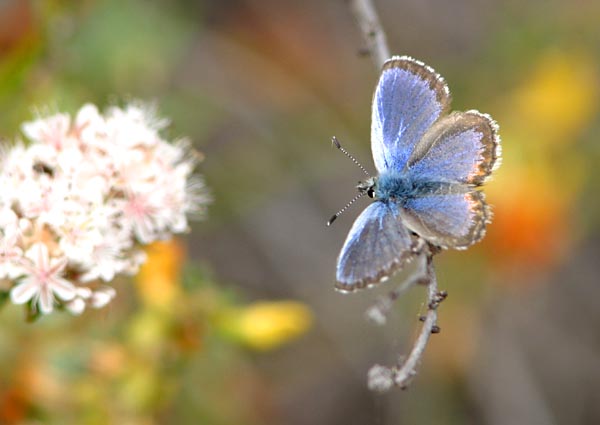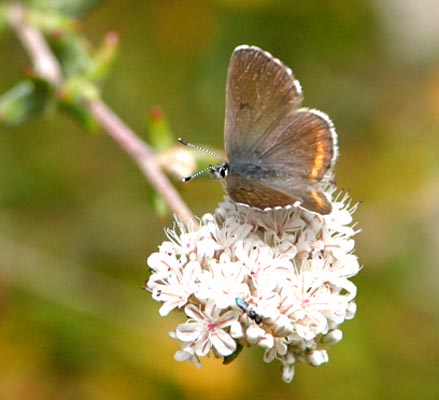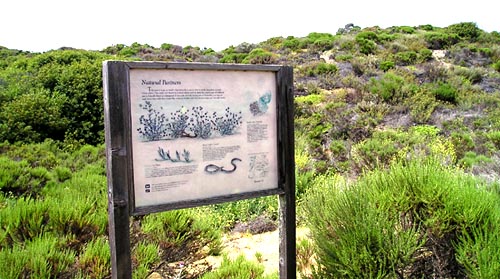|
SMITH'S BLUE BUTTERFLY
Along the shore of Monterey Bay, from Seaside north through Ft. Ord
to Marina is a set of coastal dunes. These have been coveted by developers
for years; many are degraded by sand mining, or covered with non-native
ice-plant, or heavily used as rifle ranges when Ft. Ord was operational.
But where the wild, native buckwheat (genus Eriogorum) flowers (below
left), for a short time in mid-to-late summer the tiny Smith's Blue
Butterfly Euphilotes enoptes smithi emerges from its chrysalis
and flies from buckwheat to buckwheat (below right). The flight usually
lasts only 4-6 weeks, and each individual adult butterfly lives only for
about a week, during which time it must find a mate and, if female, lay
eggs for the next generation. This taxon is listed as Endangered
under the Federal Endangered Species Act. |
|
|
|
| Males are a vivid blue color above; both sexes are similarly patterned
in white with black-and-orange spots below. This photograph of a male (right)
is about 4 times life-size. Even the photo above is about 150% of life
size for these tiny butterflies. In life, the wingspan is only ~1 inch
across. |

|

|
Females are brown above with a thin white fringe and an orange bar
across the hind wing. Males emerge first in summer, followed by females
a week later. After mating, females lay eggs on buckwheat plants. These
hatch into caterpillars later in the summer, which feed on the flowers
as they grow. Some species of ants protect the caterpillars from predators
and parasites, and receive a sugary liquid in return. The caterpillars
then pupate, and that remain dormant for the winter, until the buckwheats
flower again the next summer. Only then do the new adults emerge (Arnold
1983). |
|

| This butterfly was discovered in 1948 at the mouths of Buck and Dolan
creeks, on the Big Sur coast, by two U.C. Berkeley undergraduates, Rudi
Mattoni and Claude Smith. It appeared to be a butterfly they had never
seen before, so Mattoni collected some for future study. A few years later,
Claude Smith was swept to sea and perished while fishing at Half Moon Bay.
He had not yet finished his dissertation of the day-flying moth genus Annaphila.
When Rudi Mattoni formally described the butterfly to science (Mattoni
1955) — as a subspecies of the widespread Dotted Blue Philotes enoptes
— he named this butterfly in tribute to his friend Claude Smith. In 1975,
this butterfly was reclassified this butterfly as Shijimiaeoides enoptes
smithi, and that was the name used during the Endangered Species Act
(ESA) listing process in 1976. Soon after, Mattoni (1977) revised the tribe
Scolitantidini and transferred S. e. smithi to the genus Euphilotes. |
| The butterfly has two different lifestyles in Monterey County, both
tied closely to two species of buckwheat (E. latifolium and E.
parviolium). One population lives in the coastal dunes on Monterey
Bay — these are the ones photographed here. The other population exists
in patches of coastal chaparral near the Big Sur coast, but extending slightly
inland and upslope to Palo Corona. This latter population is the one originally
discovered by Mattoni & Smith [more on this below]. |
|
 Smith's
Blue Butterfly always had a restricted range, but development and invasive
plants decimated coastal dunes and chaparral habitats until less than half
of those habitats remained locally (Powell 1981). After several Monterey
County plants, lizards, and insects were listed as Endangered under the
federal ESA, the U.S. Army — under pressure from the local chapter of the
Native Plant Society — created a dozen of so small reserves on Ft. Ord.
One of these was Reserve #10 (left or above), created for Smith's Blue
Butterfly. This was the first federal preserve for an insect. In the 1980s,
the Youth Conservation Corps uprooted invasive ice-plant and other exotics
in the preserve (although there is still plenty of non-natives present
in these dunes). During the decommission of Ft. Ord in 1990s, the coastal
dunes were assigned for transfer to California State Parks. This transfer
should be accomplished sometime in the not-too-distant future (this is
written in July 2006). Another Threatened species, Black Legless Lizard
Anniella
pulchra nigra, also lives in these dunes [both the lizard and the butterfly
are shown on the reserve sign; ironically, almost no one sees these signs
because the area is not yet open to the public). Smith's
Blue Butterfly always had a restricted range, but development and invasive
plants decimated coastal dunes and chaparral habitats until less than half
of those habitats remained locally (Powell 1981). After several Monterey
County plants, lizards, and insects were listed as Endangered under the
federal ESA, the U.S. Army — under pressure from the local chapter of the
Native Plant Society — created a dozen of so small reserves on Ft. Ord.
One of these was Reserve #10 (left or above), created for Smith's Blue
Butterfly. This was the first federal preserve for an insect. In the 1980s,
the Youth Conservation Corps uprooted invasive ice-plant and other exotics
in the preserve (although there is still plenty of non-natives present
in these dunes). During the decommission of Ft. Ord in 1990s, the coastal
dunes were assigned for transfer to California State Parks. This transfer
should be accomplished sometime in the not-too-distant future (this is
written in July 2006). Another Threatened species, Black Legless Lizard
Anniella
pulchra nigra, also lives in these dunes [both the lizard and the butterfly
are shown on the reserve sign; ironically, almost no one sees these signs
because the area is not yet open to the public). |
| IDENTIFICATION: The taxonomy of Smith's Blue Butterfly is unsettled.
As noted above, it is currently considered a subspecies of Dotted Blue
Euphilotes
enoptes. The identification of the blue butterflies can be complex
and difficult. David Styer, however, explained to us the key features separating
Smith's Blue from its most similar species, Acmon Blue Icaricia
acmon and
Lupine Blue I. lupini
(both occur on
Ft. Ord). In Acmon/Lupine Blue, the underwings are patterned in white or
light gray and dotted with black and orange (below left). On Smith's
Blue (below right) the pattern is similar but (a) the base of
the underwings are washed with dusky and (b) the outer edge of the forewing
has a black-and-white checkerboard pattern (all-white outer edge of forewing
in Acmon/Lupine; these latter two species are separable on upperwing pattern).
The Smith's Blue in this photo is shown on a buckwheat and thus not enlarged
as much as the other shot; they are both approximately the same size. |
|
|
|
 Recently,
Pratt & Emmel (1998) proposed splitting the Monterey County populations
into two subspecies based on their host plant preference. The originally
discovered population in coastal chaparral uses only Seacliff Buckwheat
Eriogorum
parvifolium; they proposed this population be restricted as E. e.
smithi. In 2002, new populations of this taxon were discovered on recently
acquired U.S. Forest Service land near the Monterey/San Luis Obispo county
line. The authors proposed a new subspecies, E. e. arenacola — called
the Marina Blue — which they said feeds solely on Seaside Buckwheat Eriogorum
latifolium, found in coastal sand dunes. This proposal is not yet widely
adopted. For one thing, both buckwheat species occur on the Ft. Ord dunes
and the butterflies there use the both! Indeed, the buckwheat shown in
these photos is E. parvifolium, according to David Styer. For the
moment, the ESA continues to protect all Monterey populations, although,
if split, it would be the "Marina Blue" that is seriously endangered. But
given the blue's use of both plants on the Ft. Ord dunes, it seems best
at this time to continue to call them all Smith's Blue Butterfly. Recently,
Pratt & Emmel (1998) proposed splitting the Monterey County populations
into two subspecies based on their host plant preference. The originally
discovered population in coastal chaparral uses only Seacliff Buckwheat
Eriogorum
parvifolium; they proposed this population be restricted as E. e.
smithi. In 2002, new populations of this taxon were discovered on recently
acquired U.S. Forest Service land near the Monterey/San Luis Obispo county
line. The authors proposed a new subspecies, E. e. arenacola — called
the Marina Blue — which they said feeds solely on Seaside Buckwheat Eriogorum
latifolium, found in coastal sand dunes. This proposal is not yet widely
adopted. For one thing, both buckwheat species occur on the Ft. Ord dunes
and the butterflies there use the both! Indeed, the buckwheat shown in
these photos is E. parvifolium, according to David Styer. For the
moment, the ESA continues to protect all Monterey populations, although,
if split, it would be the "Marina Blue" that is seriously endangered. But
given the blue's use of both plants on the Ft. Ord dunes, it seems best
at this time to continue to call them all Smith's Blue Butterfly.
The final photo (right) shows a worn and tattered female, presumably
near the end of her week-long life as a full adult. Whatever the eventual
taxonomy, the major threat to our coast dune butterfly is loss of habitat.
These areas have been under intense pressure from development, but the
creation of Fort Ord Dune State Park is a hopeful development for the future.
Acknowledgments: I thank David Styer for showing Rita Carratello
and me these delightful little butterflies; I also thank David and Rita
for pointing out good photographic opportunities. I also thank Dave Dixon
of California State Parks for access to this restricted locale. Some of
the information herein is summarized from a more complete account by Black
& Vaughn (2005). David Styer provided useful comments on an earlier
version of this page, and Dan Singer pointed out various grammatical errors.
|
Literature cited:
Arnold, R.A., 1983. Ecological studies of six endangered butterflies
(Lepidoptera: Lycaenidae): Island biogeography, patch dynamics, and design
of habitat preserves. Univ. Calif. Publ. Entomology 99: 1-161.
Arnold, R.A., P. Couch, and K.H. Osborne. 1994. "Smith's Blue Butterfly,"
pp. 424-425 in Life on the Edge: A Guide to California's Endangered
Natural Resources (C.G. Thelander & M. Crabtree, eds.). BioSystems
Books, Santa Cruz, CA.
Black, S.H., and D.M. Vaughan. 2005. "Species Profile: Euphilotes
enoptes smithi", in Red List of Pollinator Insects of North
America (M.D.Shepherd, D.M. Vaughan & S.H. Black, eds). CD-ROM Version
1 (May 2005). The Xerces Society for Invertebrate Conservation, Portland,
OR:
Mattoni, R.H.T. 1955. Notes on the genus Philotes: I. Descriptions of
three new subspecies and a synoptic list. Bull. S. Calif. Academy Sciences
53:157-165.
Mattoni, R.H.T. 1977. The Scolitantidini. Part 1. Two new genera and
generic rearrangement (Lycaenidae). J. Research Lepidoptera 16:223-242.
(Available from http://www.doylegroup.harvard.edu/carlo/JRL/16/table_16D.html)
Powell, J.A. 1981. Endangered habitats for insects: California coastal
sand dunes. Atala 6:41-55.
Pratt, G. F. and J. F. Emmel. 1998. "Revision of the Euphilotes enoptes
and
E. battoides complexes (Lepidoptera: Lycaenidae), pp. 207-270
in
Systematics of Western North American Butterflies (T.C. Emmel, ed). Mariposa
Press, Gainsville, FL.
|
| PHOTOS: All photos are © 2006 Don Roberson; all rights
reserved.
TOP
TO LIST OF BIRD
FAMILIES OF THE WORLD
TO MONTEREY COUNTY
PAGE
TO HOME PAGE
|